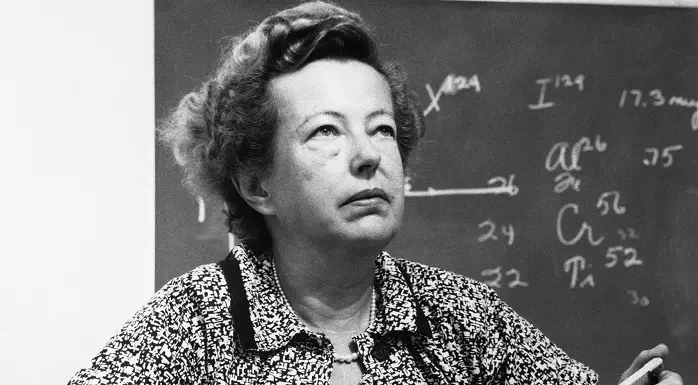
Maria Goeppert-Mayer - Scientists, Facts and Childhood
Maria Goeppert-Mayer's Personal Details
Maria Goeppert Mayer was a German-born American theoretical physicist and a joint winner of the Nobel Prize in Physics
| Information | Detail |
|---|---|
| Birthday | June 28, 1906 |
| Died on | February 20, 1972 |
| Nationality | American |
| Famous | Scientists, Physicists |
| Spouses | Joseph Edward Mayer |
| Known as | Maria Goppert-Mayer |
| Universities |
|
| Birth Place | Kattowitz, German Empire (today Katowice, Poland) |
| Gender | Female |
| Father | Friedrich Goeppert |
| Mother | Maria Wolff Goeppert |
| Sun Sign | Cancer |
| Born in | Kattowitz, German Empire (today Katowice, Poland) |
| Famous as | Physicist |
| Died at Age | 65 |
// Famous Physicists
Henry Cavendish
Henry Cavendish was a theoretical chemist and physicist, renowned for discovery of hydrogen and calculation of the mass of earth. To know more about his childhood, profile, timeline and career read on
Walter Kohn
Nobel Laureate Walter Kohn was an Austrian-born American theoretical chemist and physicist. Check out this biography to know about his childhood, life, achievements, works & timeline.
Nikola Tesla
Nikola Tesla was a Serbian-American inventor, best known for his development of alternating current electrical systems. This biography of Nikola Tesla provides detailed information about his childhood, life, achievements, works & timeline.
Maria Goeppert-Mayer's photo
Who is Maria Goeppert-Mayer?
Maria Goeppert Mayer was a German-born American theoretical physicist and a joint winner of the Nobel Prize in Physics for proposing the nuclear shell model of the atomic nucleus. She was the second female Nobel laureate in physics, the first being Marie Curie. Mayer carried on her work during a time when women were not recognized by the academia and her work was largely accepted because of her husband, Dr. Joseph Edward Mayer. She is most well-known for her research in nuclear physics, but her vast body of work in the fields of atomic and chemical physics is equally significant. Much of her work provides the theoretical foundation for several scientific discoveries in laser physics, laser isotope separation, double-beta decay, and molecular orbital calculation. At the end of World War II she attended the U.S. atomic bomb project and during this time she began her research on how atomic nuclei are built, including the puzzling "magic numbers". Even though she worked for the ‘Manhattan Project’, she was also active in the campaigns against military control of nuclear energy. Maria Goeppert Mayer was a member of the National Academy of Sciences and a corresponding member of the Akademie der Wissenschaften in Heidelberg. The American Physical Society created the Maria Goeppert Mayer Award to honor meritorious young female physicists.
// Famous Scientists
Juliane Koepcke
Juliane Koepcke is a German-Peruvian biologist, who was the lone survivor among the 92 passengers and crew of the ill-fated LANSA Flight 508 that crashed in the Peruvian rainforest on 24 December 1971. Know more about her life in this biography.
Henry Cavendish
Henry Cavendish was a theoretical chemist and physicist, renowned for discovery of hydrogen and calculation of the mass of earth. To know more about his childhood, profile, timeline and career read on
Konstantin Tsiolkovsky
Konstantin Tsiolkovsky was a Russian rocket scientist and a pioneer of astronautics. This biography provides detailed information about his childhood, family, personal life, career, achievements, etc.
Childhood & Early Life
Maria Gerturd Käte Goeppert was born on June 28, 1906, in Kattowitz, a city in Prussia. She was the only child of Maria Wolff Goeppert and Friedrich Goeppert. Friedrich was professor of paediatrics at Georgia Augusta University in Göttingen.
Göppert was educated at Höhere Technische in Göttingen, a school for girls aspiring higher education.
In 1921, she entered the Frauenstudium, a private high school run by suffragettes that prepared girls for university entrance examination.
Göppert passed the exam and in 1924 entered the University of Göttingen to study mathematics.
Very soon, she became interested in physics, and got enrolled in the Ph.D. program.
In her 1930 doctoral thesis, she proposed the theory of two-photon absorption by atoms.
Career
She shifted to the US with her husband where he had been offered a position of an associate professor of chemistry at Johns Hopkins University but since Maria had no regular academic appointment there, she taught occasional courses in the chemistry department.
From 1930 to 1939, she collaborated with her husband and the theoretical chemical physicist Karl F. Herzfeld in the fields of chemical physics and physical chemistry.
Her most important research before 1949 was a paper she wrote with Alfred Lee Sklar, a student at the Catholic University of America on how chemical structure determines optical properties.
Her work in the analysis of the spectra of complex systems based on the Hund-Mulliken approximation was elaborated in 1939 when Sklar collaborated with Hertha Sponer, Lothar Nordheim, and Edward Teller on a systematic analysis of the benzene spectrum.
In 1940, Mayer and her husband published a textbook ‘Statistical Mechanics’, on the quantum mechanical basis of statistical mechanics to chemists.
After the outbreak of World War II, Mayer joined Harold Urey’s group, the Substitute Alloy Materials Laboratory (SAM) to solve the problem of isotope separation for the Manhattan Project.
In 1945, Maria Mayer was offered the position of a voluntary associate professor at the University of Chicago.
In 1946, she took up a half-time position as research physicist in the theoretical division of the new Argonne National Laboratory.
Early in 1947, Mayer began a research on the isotopic abundances and published her results in 1948, in a paper entitled ‘On Closed Shells in Nuclei’ in which she concluded that nucleons occupy separate energy levels in the nucleus.
In the mid 1950s, she and her husband extensively travelled abroad, giving lectures and attending conferences.
In 1955, Maria Goeppert Mayer and Hans D. Jensen published the first textbook dedicated entirely to the nuclear shell model, ‘Elementary Theory of Nuclear Shell Structure’.
In 1965, she was guest of honor at Women’s Week in Japan, and in 1966 and 1967, she was a guest lecturer in India.
Major Works
Her most famous work is her theory that the nucleus consists of several shells or orbital levels, and that the degree of stability of each kind of nucleus depends on the distribution of protons and neutrons among these shells. In June 1949, she announced the results of her research. Three German scientists, Otto Haxel, J. Hans D. Jensen, and Hans Suess, also arrived at the same conclusion at the same time.
Awards & Achievements
In 1961, it was possible to experimentally verify her doctoral thesis because of the development of the laser. To honor her original contribution to this area, the unit for the two-photon absorption cross section is named the Goeppert-Mayer (GM) unit.
In 1963, Goeppert Mayer, J. Hans D. Jensen, and Eugene Wigner shared the Nobel Prize for Physics "for their discoveries concerning nuclear shell structure”.
She received honorary degrees of Doctor of Science from Russel Sage College, Mount Holyoke College, and Smith College.
Personal Life & Legacy
On January 19, 1930, Goeppert married Joseph Edward Mayer, an American Rockefeller fellow who was one of the assistants to the scientist, James Franck.
After marriage, the couple moved to Mayer's home country, the United States. They had two children, Maria Ann and Peter Conrad.
On February 20, 1972, Maria Goeppert Mayer died in San Diego, California, after a stroke left her comatose.
She was buried at El Camino Memorial Park in San Diego.
The University of California at San Diego organizes an annual Maria Goeppert Mayer symposium that brings together female researchers to talk about current science.
In 2011, her name was included in the third issue of the ‘American Scientists’ compilation of US postage stamps.
Trivia
Maria's idea to compare the atomic nuclei with an onion, made Wolfgang Pauli, a noted physicist, give her the nickname “The Onion Madonna”.
Mayer had great interest in Native American pottery and archaeology.
// Famous Cancer Celebrities peoples
Jacob Elordi
Jacob Elordi is an Australian actor. Let’s take a look at his childhood, family, personal life, career, etc.
Riele Downs
Riele Downs is a Canadian-American actress & Musical.ly star. Let’s take a look at her family and personal life including age, birthday, net worth, boyfriends and fun facts.
Yammy Xox
Check out all that you wanted to know about Yammy Xox, the famous British YouTube Personality; her birthday, her family and personal life, her boyfriends, fun trivia facts and more.
Maria Goeppert-Mayer's awards
| Year | Name | Award |
|---|---|---|
Other | ||
| 0 | Nobel Prize for Physics (1963) | |
Maria Goeppert-Mayer biography timelines
- // 28th Jun 1906Maria Gerturd Käte Goeppert was born on June 28, 1906, in Kattowitz, a city in Prussia. She was the only child of Maria Wolff Goeppert and Friedrich Goeppert. Friedrich was professor of paediatrics at Georgia Augusta University in Göttingen.
- // 1921In 1921, she entered the Frauenstudium, a private high school run by suffragettes that prepared girls for university entrance examination.
- // 1924Göppert passed the exam and in 1924 entered the University of Göttingen to study mathematics.
- // 1930In her 1930 doctoral thesis, she proposed the theory of two-photon absorption by atoms.
- // 1930 To 1939From 1930 to 1939, she collaborated with her husband and the theoretical chemical physicist Karl F. Herzfeld in the fields of chemical physics and physical chemistry.
- // 19th Jan 1930On January 19, 1930, Goeppert married Joseph Edward Mayer, an American Rockefeller fellow who was one of the assistants to the scientist, James Franck.
- // 1939Her work in the analysis of the spectra of complex systems based on the Hund-Mulliken approximation was elaborated in 1939 when Sklar collaborated with Hertha Sponer, Lothar Nordheim, and Edward Teller on a systematic analysis of the benzene spectrum.
- // 1940In 1940, Mayer and her husband published a textbook ‘Statistical Mechanics’, on the quantum mechanical basis of statistical mechanics to chemists.
- // 1945In 1945, Maria Mayer was offered the position of a voluntary associate professor at the University of Chicago.
- // 1946In 1946, she took up a half-time position as research physicist in the theoretical division of the new Argonne National Laboratory.
- // 1947 To 1948Early in 1947, Mayer began a research on the isotopic abundances and published her results in 1948, in a paper entitled ‘On Closed Shells in Nuclei’ in which she concluded that nucleons occupy separate energy levels in the nucleus.
- // 1949Her most important research before 1949 was a paper she wrote with Alfred Lee Sklar, a student at the Catholic University of America on how chemical structure determines optical properties.
- // Jun 1949Her most famous work is her theory that the nucleus consists of several shells or orbital levels, and that the degree of stability of each kind of nucleus depends on the distribution of protons and neutrons among these shells. In June 1949, she announced the results of her research. Three German scientists, Otto Haxel, J. Hans D. Jensen, and Hans Suess, also arrived at the same conclusion at the same time.
- // 1955In 1955, Maria Goeppert Mayer and Hans D. Jensen published the first textbook dedicated entirely to the nuclear shell model, ‘Elementary Theory of Nuclear Shell Structure’.
- // 1961In 1961, it was possible to experimentally verify her doctoral thesis because of the development of the laser. To honor her original contribution to this area, the unit for the two-photon absorption cross section is named the Goeppert-Mayer (GM) unit.
- // 1963In 1963, Goeppert Mayer, J. Hans D. Jensen, and Eugene Wigner shared the Nobel Prize for Physics "for their discoveries concerning nuclear shell structure”.
- // 20th Feb 1972On February 20, 1972, Maria Goeppert Mayer died in San Diego, California, after a stroke left her comatose.
- // 2011In 2011, her name was included in the third issue of the ‘American Scientists’ compilation of US postage stamps.
// Famous American peoples
Wentworth Miller
Wentworth Miller is an American actor and screenwriter who achieved recognition for his role in the TV series ‘Prison Break’.
Jason Simpson
Jason Simpson is the son of former NFL running back, broadcaster and actor O. J. Simpson. Check out this biography to know about his childhood, family, life, and little known facts about him.
Melissa Brim
Melissa Brim is the ex-girlfriend of former professional boxer Floyd Mayweather Jr. Check out this biography to know about her birthday, childhood, family life, achievements and fun facts about her.
Skai Jackson
Skai Jackson is an American child actress with huge fan following. Find more about her family & personal life, relationships, facts and more.
Joyce Meyer
Joyce Meyer is a Christian author and speaker. This biography provides detailed information about her childhood, life, achievements, works & timeline
Zoe LaVerne
Zoe LaVerne is an American musical.ly star. Check out this biography to know more about her family, personal life, including her age, birthday, etc.
Maria Goeppert-Mayer's FAQ
What is Maria Goeppert-Mayer birthday?
Maria Goeppert-Mayer was born at 1906-06-28
When was Maria Goeppert-Mayer died?
Maria Goeppert-Mayer was died at 1972-02-20
Where was Maria Goeppert-Mayer died?
Maria Goeppert-Mayer was died in San Diego
Which age was Maria Goeppert-Mayer died?
Maria Goeppert-Mayer was died at age 65
Where is Maria Goeppert-Mayer's birth place?
Maria Goeppert-Mayer was born in Kattowitz, German Empire (today Katowice, Poland)
What is Maria Goeppert-Mayer nationalities?
Maria Goeppert-Mayer's nationalities is American
Who is Maria Goeppert-Mayer spouses?
Maria Goeppert-Mayer's spouses is Joseph Edward Mayer
What was Maria Goeppert-Mayer universities?
Maria Goeppert-Mayer studied at University of Göttingen
Who is Maria Goeppert-Mayer's father?
Maria Goeppert-Mayer's father is Friedrich Goeppert
Who is Maria Goeppert-Mayer's mother?
Maria Goeppert-Mayer's mother is Maria Wolff Goeppert
What is Maria Goeppert-Mayer's sun sign?
Maria Goeppert-Mayer is Cancer
How famous is Maria Goeppert-Mayer?
Maria Goeppert-Mayer is famouse as Physicist















